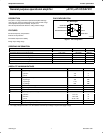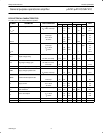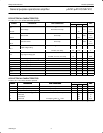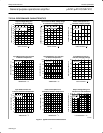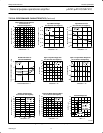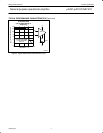
Philips Semiconductors Product specification
µA741/µA741C/SA741CGeneral purpose operational amplifier
1994 Aug 31
5
TYPICAL PERFORMANCE CHARACTERISTICS
–55
o
C < T
A
< +125
o
C
R
L
> 2kΩ
40
36
32
28
24
20
16
12
8
4
0
5 10 15 20
SUPPLY VOLTAGE — +
V
PEAK TO PEAK OUTPUT SWING — V
–55
o
C < T
A
< +125
o
C
16
14
12
10
8
6
4
2
0
5 10 15 20
SUPPLY VOLTAGE — +
V
COMMON MODE VOLTAGE RANGE — V
+
T
A
= 25
o
C
100
80
60
40
20
0
5 10 15 20
SUPPLY VOLTAGE — +
V
POWER CONSUMPTION — mW
V
S
= +15V
500
400
300
200
100
0
–60 –20 20 60 100 140
TEMPERATURE —
o
C
INPUT BIAS CURRENT — nA
10.0
5.0
3.0
1.0
0.5
0.3
0.1
–60 –20 20 60 100 140
TEMPERATURE —
o
C
INPUT RESISTANCE — MΩ
T
A
= 25
o
C
T
A
= 25
o
C
SUPPLY VOLTAGE — +
V
40
30
20
10
0
5 10 15 20
INPUT OFFSET CURRENT – nA
V
S
= ±15
o
C
140
120
100
80
60
40
20
0
–60 –20 20 60 100 140
TEMPERATURE —
o
C
INPUT OFFSET CURRENT — nA
70
60
50
40
30
–60 –20 20 60 100 140
TEMPERATURE —
o
C
POWER CONSUMPTION — mW
V
S
= +15V
T
A
= 25
o
C
28
26
24
22
20
18
16
14
12
10
8
0.1 0.2 0.5 1.0 2.0 5.0 10
LOAD RESISTANCE — kΩ
PEAK–TO–PEAK OUTPUT SWING — V
Output Voltage Swing as a
Function of Supply Voltage
Input Common–Mode Voltage Range
as a Function of Supply Voltage
Power Consumption as a
Function of Supply Voltage
Input Bias Current as a Function
of Ambient Temperature
Input Resistance as a Function
of Ambient Temperature
Input Offset Current as a
Function of Supply Voltage
Input Offset Current as a
Function of Ambient Temperature
Power Consumption as a
Function of Ambient Temperature
Output Voltage Swing as a
Function of Load Resistance
V
S
= ±15
o
C
SL00097
Figure 3. Typical Performance Characteristics



